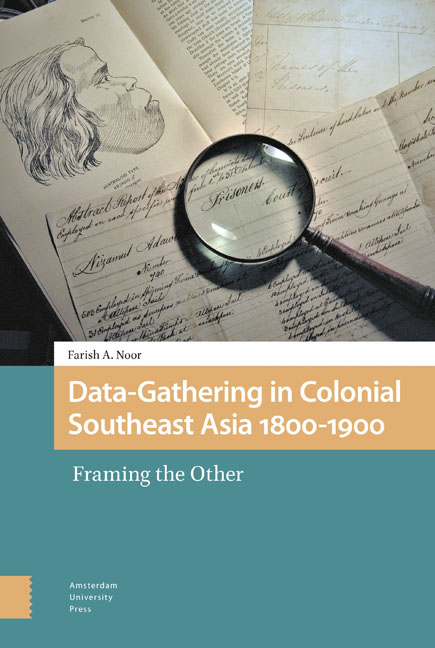Book contents
- Frontmatter
- Dedication
- Contents
- A Note on Spelling
- Introduction: The Panopticon in the Indies: Data-Gathering and the Power of Knowing
- 1 Caught in the Eye of Empire: Stamford Raffles’ 1814 Java Regulations
- 2 Deadly Testimonies: John Crawfurd’s Embassy to the Court of Ava and the Framing of the Burman
- 3 Fairy Tales and Nightmares: Identifying the ‘Good’ Asians and the ‘Bad’ Asians in the Writings of Low St. John
- 4 The Needle of Empire: The Mapping of the Malay in the works of Daly and Clifford
- 5 The Panopticon in the Indies: Data-collecting and the Building of the Colonial State in Southeast Asia
- Appendix A Proclamation of Lord Minto, Governor-General of British India, at Molenvliet, Java, 11 September 1811
- Appendix B Proclamation of Stamford Raffles, Lieutenant-General of Java, At Batavia, Java, 15 October 1813
- Appendix C The Treaty of Peace Concluded at Yandabo
- Appendix D The Treaty of Friendship and Commerce between Her Majesty and the Sultan of Borneo (Brunei). Signed, in the English and Malay Languages, 27 May 1847
- Appendix E The Racial Census employed in British Malaya from 1871 to 1931
- Timeline of Events and Developments in Southeast Asia 1800-1900
- Bibliography
- Index
4 - The Needle of Empire: The Mapping of the Malay in the works of Daly and Clifford
Published online by Cambridge University Press: 21 November 2020
- Frontmatter
- Dedication
- Contents
- A Note on Spelling
- Introduction: The Panopticon in the Indies: Data-Gathering and the Power of Knowing
- 1 Caught in the Eye of Empire: Stamford Raffles’ 1814 Java Regulations
- 2 Deadly Testimonies: John Crawfurd’s Embassy to the Court of Ava and the Framing of the Burman
- 3 Fairy Tales and Nightmares: Identifying the ‘Good’ Asians and the ‘Bad’ Asians in the Writings of Low St. John
- 4 The Needle of Empire: The Mapping of the Malay in the works of Daly and Clifford
- 5 The Panopticon in the Indies: Data-collecting and the Building of the Colonial State in Southeast Asia
- Appendix A Proclamation of Lord Minto, Governor-General of British India, at Molenvliet, Java, 11 September 1811
- Appendix B Proclamation of Stamford Raffles, Lieutenant-General of Java, At Batavia, Java, 15 October 1813
- Appendix C The Treaty of Peace Concluded at Yandabo
- Appendix D The Treaty of Friendship and Commerce between Her Majesty and the Sultan of Borneo (Brunei). Signed, in the English and Malay Languages, 27 May 1847
- Appendix E The Racial Census employed in British Malaya from 1871 to 1931
- Timeline of Events and Developments in Southeast Asia 1800-1900
- Bibliography
- Index
Summary
Malaya, land of the pirate and the amok, your secrets have been well guarded, but the enemy has at last passed your gate, and soon the irresistible juggernaut of Progress will have penetrated to your remotest fastness, ‘civilised’ your people, and stamped them with the seal of a higher morality.
Frank Swettenham,Malay Sketches (1895)Elbow Room for Empire: Britain's Expansion into the Malay Kingdoms
As the world ‘filled up’, influence by default was no longer an option. The British were pushed into formalizing their claims, and sometimes backing them up with displays of force. […] The result was paradoxical. Although the British Empire became larger and larger, the diplomats and strategists charged with protecting it became more and more anxious.
John Darwin,After TamerlaneThe 1857 disturbances in Sarawak were in some ways a prelude to more violence. By the second half of the 19th century the race for Empire was on, and Southeast Asia would soon bear the brunt of renewed campaigns by the Western powers to expand their sphere of influence even further; and there would be new imperial actors on the scene that included Japan and the United States of America (Noor, 2018). Empire rested upon its global economy, and by the late 1870s Europe and the United States supplied threequarters of the world's trade goods and consumed 77 percent of imports that were circulating worldwide. Along with trade came the expansion of territory, and as Darwin (2008) has noted, by the last quarter of the 19th century France's overseas empire ‘grew by more than twelve times from 350,000 square miles to 4.6 million’, while the French Empire's population grew to 50 million.
Britain's colonial possessions in Southeast Asia in the mid-19th century were still relatively small, though destined to grow. Burma had yet to be defeated and conquered for good, while Britain's territories in the Malayan Peninsula were confined to Penang, Malacca and Singapore – later brought together as the Straits Settlements. Sarawak was under the rule of a quixotic Englishman who had declared himself Rajah.
- Type
- Chapter
- Information
- Data-Gathering in Colonial Southeast Asia 1800–1900Framing the Other, pp. 153 - 188Publisher: Amsterdam University PressPrint publication year: 2019



